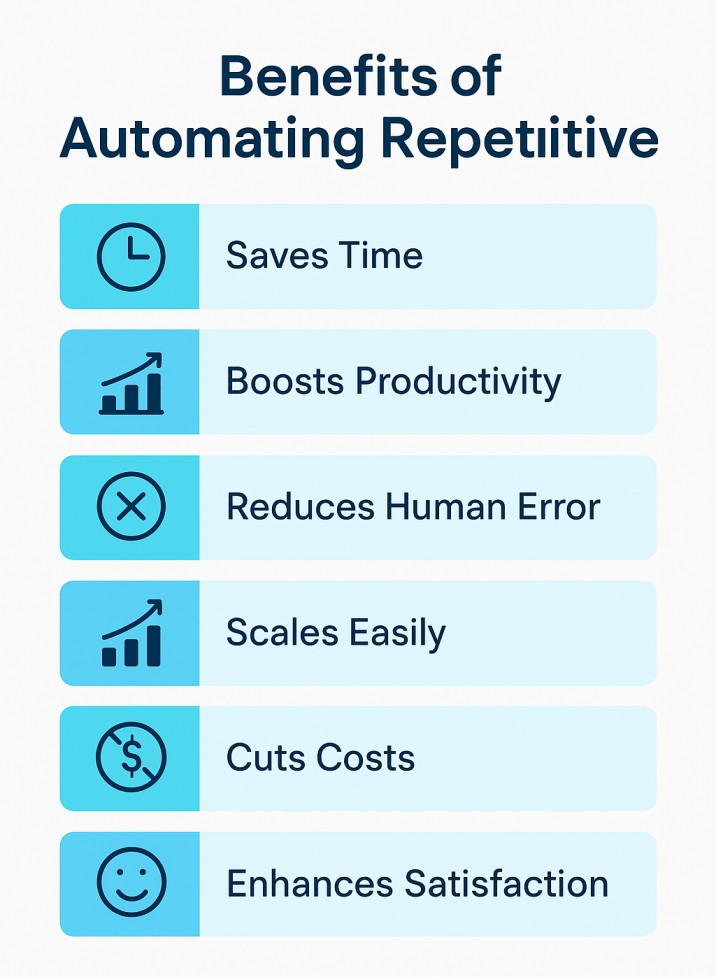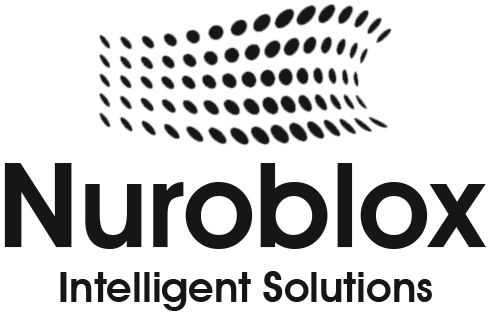How to Automate Repetitive Tasks and Save Hours Every Week
Do you find yourself performing the same tasks over and over, updating spreadsheets, sending follow up emails, or copying data between apps? These repetitive tasks not only eat up your time but also drain your focus from higher value work that truly moves the needle.
The good news? Most of these tasks can be automated.
Thanks to modern automation tools and no-code platforms, individuals and businesses can now streamline everyday workflows, reduce manual errors, and reclaim hours every week. Whether you’re a solo entrepreneur, a small business owner, or part of a large team, learning how to automate repetitive work is one of the smartest productivity moves you can make.
In this guide, we’ll walk you through what repetitive task automation is, how to get started, which tools to use, and real world examples to inspire your next workflow upgrade.
Let’s dive in and start saving time, one automation at a time.
What Are Repetitive Tasks?
Repetitive tasks are routine activities that are performed frequently and follow the same set of steps every time. These tasks typically require minimal human judgment and are often necessary but time consuming parts of everyday work.
They may include:
- Copying and pasting data between systems
- Manually sending reminder emails
- Scheduling recurring meetings
- Approving standard requests
- Updating records in spreadsheets or CRMs
Because they are rule based, predictable, and often mundane, repetitive tasks are ideal candidates for automation. When automated, they can be completed faster, with fewer errors, and without constant human oversight, freeing you up to focus on more meaningful, creative, or strategic work.
Benefits of Automating Repetitive Tasks

Automating repetitive tasks brings immediate and long term advantages to individuals, teams, and organizations. Here are the key benefits:
Saves Time: Automation significantly reduces the time spent on manual, recurring actions. Tasks that once took hours, like data entry, follow ups, or report generation, can now be completed in seconds.
Boosts Productivity: By eliminating routine work, employees can focus on higher impact activities like strategy, problem solving, and customer engagement. This leads to better performance and improved output across the board.
Reduces Human Error: Repetitive manual processes are prone to mistakes. Automation ensures tasks are completed consistently and accurately, improving data quality and reducing costly errors.
Scales Easily: Automated processes can handle a growing workload without additional effort or cost. Whether you’re sending 10 emails or 10,000, the system works just as efficiently.
Cuts Costs: Less time spent on manual work means fewer resources are needed to achieve the same (or better) results. Over time, this leads to noticeable cost savings.
Enhances Satisfaction: No one enjoys doing the same mindless tasks every day. Automating them reduces burnout and allows team members to focus on creative and rewarding work.
By automating repetitive tasks, you’re not just improving workflows, you’re setting the stage for a more efficient, accurate, and empowered work environment.
Step by Step Guide to Getting Started with Task Automation
Automating repetitive tasks can save hours every week, reduce human error, and let you focus on higher value work. Here’s how to get started using popular automation tools even if you’re not a developer.
Step 1: Identify the Task You Want to Automate
Start by listing the tasks you do every day or week that follow a repeatable pattern. These are typically good candidates for automation.
Examples:
- Copying data from emails to spreadsheets
- Sending follow up emails after a form submission
- Notifying your team when a new customer signs up
- Saving social media content to a database
Tip: Focus on tasks that are rule based and don’t require much human judgment.
Step 2: Choose the Right Automation Tool
Select a tool that fits your technical comfort level and app ecosystem.
| Tool | Best For |
| Zapier | No-code workflows across SaaS apps |
| Make (Integromat) | Advanced, logic heavy automations |
| Microsoft Power Automate | Ideal for Microsoft 365 users |
| UiPath | Enterprise grade RPA workflows |
| Workato | Complex data integration at scale |
Step 3: Connect Your Apps
Most automation tools allow you to connect to hundreds (or thousands) of apps via API. You’ll need to:
- Sign in to your app accounts (e.g., Gmail, Trello, Google Sheets)
- Authorize the automation tool to access those accounts
- Test the connection to ensure integration works properly
Step 4: Set Your Trigger (When the Task Starts)
A trigger is the event that starts your automation.
Examples of triggers:
- A new email received
- A form is submitted
- A new row is added to a spreadsheet
- A customer completes a purchase
Example (Zapier): “When a new lead fills out my Typeform form…”
Step 5: Define the Action (What Happens Next)
An action is what you want the tool to do automatically after the trigger.
Common actions include:
- Send an email or message
- Create a new document or task
- Update a CRM record
- Move a file to cloud storage
- Post on social media
Example (Zapier): “…then send a Slack message to the sales team.”
Step 6: Test Your Automation
Run a test to make sure everything works as expected. Check if:
- The correct data is transferred
- The action happens in real time or on schedule
- The workflow handles errors or missing fields
Most tools offer a test mode to preview the automation before making it live.
Step 7: Turn It On and Monitor
Once you’ve tested it successfully, turn the automation on. Over time:
- Monitor the task history to catch errors
- Review logs or reports if something fails
- Adjust as your process evolves
Top Tools to Automate Repetitive Tasks in 2025
The right automation tool can save you countless hours and reduce errors across your workflows. Here are some of the top rated automation platforms in 2025 that help individuals and businesses eliminate repetitive tasks effortlessly:
1. Zapier – No-Code Automation for Everyday Apps
Best for: Small to mid-sized businesses, marketers,
Zapier is one of the most popular no-code automation platforms. It connects over 6,000 apps like Gmail, Slack, Google Sheets, HubSpot, and Trello and enables users to create “Zaps” that automate repetitive tasks.
Key Features:
- Easy drag and drop workflow builder
- Multi-step workflows and conditional logic
- Webhooks and custom APIs for advanced users
- Task history and error reporting
2. Make (formerly Integromat) – Visual Automation with Power
Best for: Tech savvy users and developers
Make offers a powerful visual editor that allows users to build complex automations using conditional logic, data formatting, and error handling. It supports advanced features like iterations, variables, and API connections.
Key Features:
- Real time scenario execution
- Support for custom API modules
- Reusable workflows and scheduling
- Extensive control over data manipulation
3. UiPath – Enterprise Grade Robotic Process Automation (RPA)
Best for: Enterprises and large organizations
UiPath is a leading RPA platform that allows businesses to automate rule based tasks using software robots. It’s built for handling complex back office operations in industries like finance, healthcare, insurance, and logistics.
Key Features:
- Desktop and web automation
- AI-powered document understanding
- Workflow analytics and monitoring
- Advanced security and compliance
4. Microsoft Power Automate – Automation for the Microsoft Ecosystem
Best for: Microsoft 365 users, mid to large businesses
Power Automate integrates natively with Microsoft Office, Teams, SharePoint, and Dynamics 365. It allows users to automate tasks across Microsoft services as well as third party apps.
Key Features:
- Pre-built templates for common workflows
- Integration with AI Builder
- Real time triggers from Microsoft apps
- Desktop flow automation with RPA support
5. Workato – Enterprise Integration + Automation
Best for: Enterprises needing deep app integration
Workato combines iPaaS (integration platform as a service) with powerful automation. It’s ideal for large organizations needing to sync data and processes across departments and platforms.
Key Features:
- 1,000+ connectors and pre-built “recipes”
- Real time bi-directional data sync
- Embedded automation in SaaS products
- Enterprise grade security and governance
Common Mistakes to Avoid When Automating Repetitive Tasks
Automation can be a game changer but only when implemented thoughtfully. Many people dive into task automation without proper planning, which leads to inefficiencies, errors, or even more manual work. Here are some common mistakes to watch out for:
Automating the Wrong Tasks
Not all tasks are worth automating. Some require human judgment, creativity, or are too infrequent to justify the setup time.
Tip: Focus on tasks that are rule based, repetitive, and time consuming.
Skipping Workflow Planning
Jumping straight into an automation tool without mapping the process can cause missed steps or confusion.
Tip: Outline your workflow on paper or a flowchart. Know your triggers, actions, and decision points.
Choosing the Wrong Tool
Each tool has its strengths. Using a simple tool for a complex process or an overly complex tool for a simple task can waste time and money.
Tip: Match the tool to your use case, technical skill level, and app ecosystem.
Not Testing Before Launch
Launching automation without proper testing can lead to data errors, missed actions, or duplicate messages.
Tip: Always run test cases and verify each step behaves as expected before going live.
Ignoring Maintenance
Automations can break when connected apps change their APIs, names, or access permissions.
Tip: Set reminders to regularly review and update workflows. Use alerts or logs to monitor failures.
Overcomplicating the Workflow
Trying to do too much in one automation can make debugging harder and reduce reliability.
Tip: Keep workflows as simple and modular as possible. Break complex flows into smaller automations.
Conclusion
Automating repetitive tasks isn’t just a productivity hack it’s a strategic move to free up time, reduce errors, and focus on what truly matters. By identifying manual workflows, choosing the right tools, and implementing thoughtful automation, you can reclaim hours every week and work smarter, not harder.
Whether you’re managing a small business, a growing team, or your workload, start small, test often, and scale as you go. The future of work is automated, and the best time to start is now.


